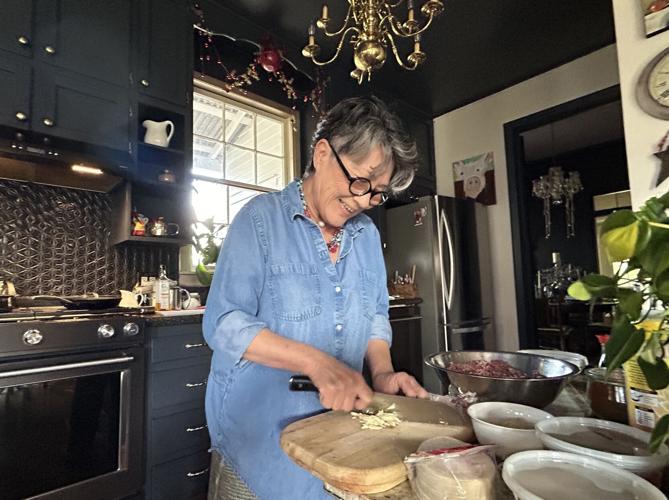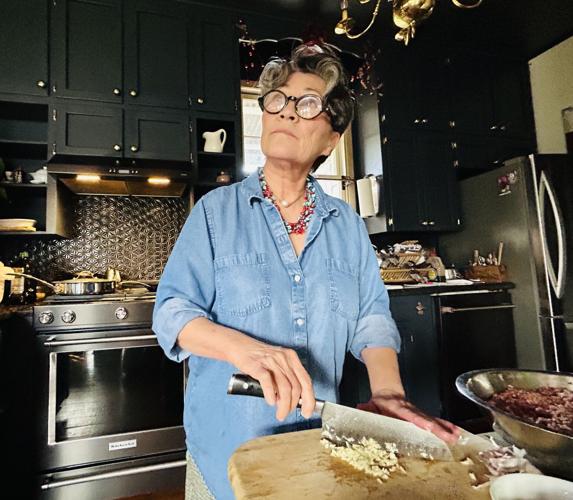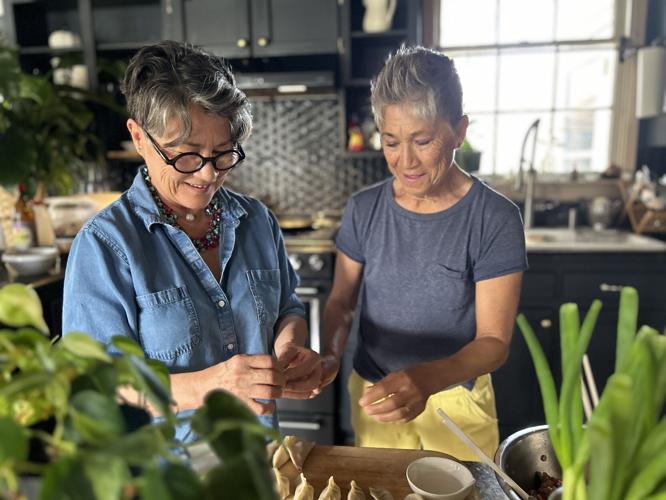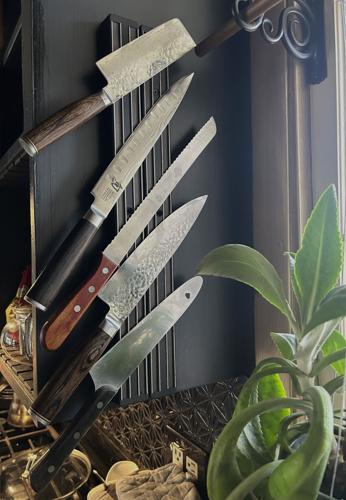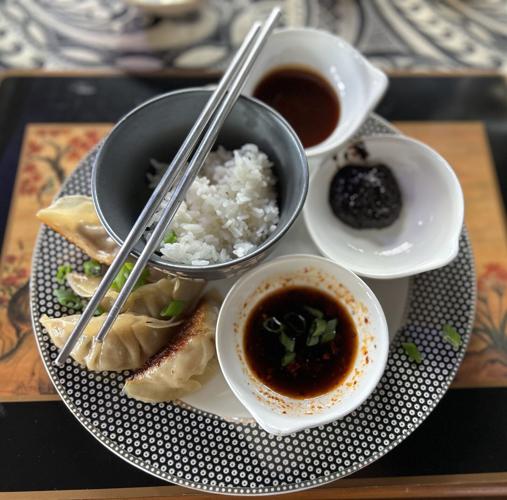Whatever you cook, Mary Patout can make it better with her condiments — mustards, micro-greens and myriad sauces — which bring magnificent flavors to the plate. She invited me to cook with her at her home in St. Martinville where she inspired me with her passion for sauces and shared stories of living out her “need to feed” people.
Her sister cheerfully greeted me on the front porch, in a neighborhood close to Bayou Teche, and led me into Patout’s wonderfully unique kitchen. Flanked on one side with dramatically dark charcoal-colored cabinets, the space was surprisingly bright, lit by two walls of windows. Vibrant green plants were perched at various levels. Art and a well-curated kitchen knife collection decorated the walls. Comfortable chairs filled the room surrounding the island where Patout chopped green onions and welcomed me with a smile.

Mary Patout’s knives in her St. Martinville kitchen.
We began with wine and vinegar — a cool white to drink and a black vinegar she was excited about using in a sauce for the gyoza (Japanese dumplings) we would be making.
Patout pulls culinary inspiration from her life lived all over the U.S. and abroad as the daughter of a U.S. airman from the northeast and a mother who hailed from Japan. She inherited her need to feed people from her mother who cooked foods like eggrolls and gyoza at home, adding gumbo and étouffée to her repertoire when the family moved to Louisiana when Patout was 18.
With her mother as inspiration, Patout and her late husband Roy Patout were charter members of the Lafayette Farmers and Artisans Market where they wowed people with their homemade mustards, handmade ramen and special treats like takoyaki (fried octopus balls). After she saw a homemade mustard recipe in an article about unique Christmas gifts, Mary Patout began her riff on the oft-misrepresented condiment.
Freshly made, her mustard contained a healthy portion of experimentation. Her husband was her chief taster as she played with various additions: locally brewed beer, lavender, port and the Champagne grapes that caught her eye at the store. She grew mustard greens, incorporating the young microgreens for an additional dimension of mustardness. People loved it, and she often sold out.

Mary Patout in her kitchen.
For several years, Mary Patout grew microgreens and specialty herbs such as cilantro, tarragon and a basil-like Japanese herb called shiso — providing the wow factor in many a dish at local restaurants like Social Southern Table & Bar and French Press in Lafayette.
Her husband built the greenhouses that protected her valuable produce but, smiling, she recalled how he once overzealously weed-whacked a crop of shiso growing outdoors that had been reserved by chef Manny Augello. Forgiveness and a call to a fellow grower saved the day. Mary Patout made a reputation for herself and was often sought out by local chefs looking for ways to enhance their creations.
Umami, the taste of earthy savoriness, is her forte. For the gyoza, she prepared three sauces that embodied this taste: a fermented black bean sauce, Mary’s Bulldog Sauce (an okonomiyaki sauce with oyster sauce, ketchup and Worcestershire) and the dipping sauce featured in the included recipe.
Fun is another of Patout’s strengths.

Mary Patout and her sister Janet Hanemann make gyoza in Patout's St. Martinville kitchen.
After demonstrating how to carefully make pleats in the gyoza dumplings, she and her sister showed “how Mom would have done it” with a quick no-frills pinching together of the two sides. Their late mother came to life in their banter as we folded dumplings and they told of when the family moved from Satellite Beach, Florida, to Anchorage, Alaska. Near the end of the 5,000-mile road trip and during the thirteenth flat tire change, their mother decided she’d had enough and started walking back to Florida. Reason prevailed, and the entire family eventually made it to Alaska — but even decades later, I got the sense these two women were still relieved they completed the journey north with the family intact.
At the table with Mary Patout, her sister and her brother-in-law, I got the feeling that she is at the beginning of a new journey. No longer in the business of growing microgreens, she spoke of wanting to teach cooking classes. Her gyoza were delicious, their flavor amplified with each dip in the various sauces.
Sign me up.

Mary Patout's gyoza served with rice and three sauces in her St. Martinville home.
Gyoza with Dipping Sauce
Serves 6-8
Recipe is by Mary Patout
For the gyoza:
1/2 pound ground beef
1/2 pound ground pork
2 cups plus 1 tablespoon sake, divided
1 tablespoon sesame oil
1 tablespoon soy sauce
1/4 teaspoon salt
1/2 teaspoon cayenne or black pepper
2 cloves garlic, minced
1 knob ginger, grated or minced
Small handful of garlic chives or green onions, chopped fine
1 12-ounce package dumpling wrappers
Vegetable oil for browning
For the dipping sauce:
1/2 cup Japanese black vinegar or Chinese black vinegar
1/2 cup soy sauce
Chili crisp to taste
1. Allow the wrappers to come to room temperature so the edges will stick better.
2. In a large bowl, combine the meat plus 1 tablespoon each of sake, sesame oil and soy sauce. Add salt, pepper, garlic, ginger, and chives/green onions. Mix well with a spoon or by hand and set aside.
3. Optional: Pan fry a small pinch of the meat mixture until thoroughly cooked — taste and adjust seasonings if necessary.
4. Combine the ingredients for the dipping sauce.
5. Assemble the gyoza — place a tablespoon of the meat mixture in the center of a dumpling wrapper, fold the wrapper in half, and pinch the seam edges together to seal them. Make sure the edges of the wrappers are tightly sealed.
6. Continue assembling gyoza until the meat mixture runs out, covering the completed ones with a damp towel to ensure they do not dry out before cooking.
7. Using a medium nonstick skillet with lid, heat 2 tablespoons vegetable oil. Add gyoza one at a time, without overcrowding the pan. Brown one side of the gyoza then carefully unstick any that may stick to the pan before moving on to the next step.
8. Add 1/4 cup sake (or water) to the skillet. Cover with lid and steam for 3-4 minutes.
9. Serve warm with small individual bowls of dipping sauce at each place setting.

